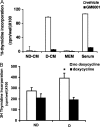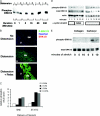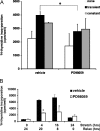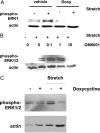Mechanotransduction of extracellular signal-regulated kinases 1 and 2 mitogen-activated protein kinase activity in smooth muscle is dependent on the extracellular matrix and regulated by matrix metalloproteinases
- PMID: 16877348
- PMCID: PMC1698787
- DOI: 10.2353/ajpath.2006.050969
Mechanotransduction of extracellular signal-regulated kinases 1 and 2 mitogen-activated protein kinase activity in smooth muscle is dependent on the extracellular matrix and regulated by matrix metalloproteinases
Abstract
Excessive wall stretch of distensible hollow organs in cardiovascular and urinary systems can activate matrix metalloproteinases (MMPs), thereby releasing matrix neoepitopes and growth factor ligands, leading to ERK1/2 activation. However, the role of MMPs in mechanotransduction of ERK1/2 signaling in the bladder is unknown. We examined bladders undergoing sustained distension over time, which provides a novel platform for smooth muscle mechanotransduction studies. Bladder distension ex vivo caused increased proliferation and MMP activity. Conditioned medium from distended compared with undistended bladders induced proliferation in bladder smooth muscle cells (BSMCs). When conditioned medium from distended bladders was used to proteolyze collagen type I matrices, matrices augmented BSMC proliferation, which was inhibited if bladders were distended in presence of broad-spectrum MMP inhibitors. Distension of ex vivo bladders also induced ERK1/2 phosphorylation in situ, which was dependent on MMP activity in the intact bladder. Similarly, stretching BSMCs in vitro induced increases in ERK1/2 activation and ERK1/2-dependent proliferation under discrete mechanical conditions, and distension conditioned medium itself induced MMP-dependent ERK1/2 activation in BSMCs. Overall, stretch-induced proliferation and ERK1/2 signaling in bladder tissue and BSMCs likely depend on secreted MMP activity. Identification of intermediaries between MMPs and ERK1/2 may elaborate novel mechanisms underlying mechanotransduction in bladder smooth muscle.
Figures








Similar articles
-
Matrix metalloproteinase-7 and epidermal growth factor receptor mediate hypoxia-induced extracellular signal-regulated kinase 1/2 mitogen-activated protein kinase activation and subsequent proliferation in bladder smooth muscle cells.In Vitro Cell Dev Biol Anim. 2006 May-Jun;42(5-6):124-33. doi: 10.1290/0510070.1. In Vitro Cell Dev Biol Anim. 2006. PMID: 16848631
-
Basic fibroblast growth factor modulates proliferation and collagen expression in urinary bladder smooth muscle cells.Am J Physiol Renal Physiol. 2007 Oct;293(4):F1007-17. doi: 10.1152/ajprenal.00107.2007. Epub 2007 Jul 18. Am J Physiol Renal Physiol. 2007. PMID: 17634401
-
Role of the extracellular signal-regulated kinase 1/2 signaling pathway in regulating the secretion of bronchial smooth muscle cells in a rat model of chronic asthma.Chin Med J (Engl). 2008 Jan 5;121(1):73-7. Chin Med J (Engl). 2008. PMID: 18208670
-
[Overactive bladder--a new insight into the pathogenesis of its idiopathic form].Ginekol Pol. 2012 Nov;83(11):844-8. Ginekol Pol. 2012. PMID: 23379193 Review. Polish.
-
Airway smooth muscle--its relationship to the extracellular matrix.Respir Physiol Neurobiol. 2003 Sep 16;137(2-3):339-46. doi: 10.1016/s1569-9048(03)00157-5. Respir Physiol Neurobiol. 2003. PMID: 14516736 Review.
Cited by
-
A TALEN-Exon Skipping Design for a Bethlem Myopathy Model in Zebrafish.PLoS One. 2015 Jul 29;10(7):e0133986. doi: 10.1371/journal.pone.0133986. eCollection 2015. PLoS One. 2015. PMID: 26221953 Free PMC article.
-
The bladder extracellular matrix. Part I: architecture, development and disease.Nat Rev Urol. 2009 Nov;6(11):596-611. doi: 10.1038/nrurol.2009.201. Nat Rev Urol. 2009. PMID: 19890339 Review.
-
Pathologic bladder microenvironment attenuates smooth muscle differentiation of skin derived precursor cells: implications for tissue regeneration.PLoS One. 2013;8(4):e59413. doi: 10.1371/journal.pone.0059413. Epub 2013 Apr 1. PLoS One. 2013. PMID: 23560047 Free PMC article.
-
Increased interleukin-6 and TP53 levels in rotator cuff tendon repair patients with hypercholesterolemia.Clin Shoulder Elb. 2022 Dec;25(4):296-303. doi: 10.5397/cise.2022.00976. Epub 2022 Aug 16. Clin Shoulder Elb. 2022. PMID: 35971601 Free PMC article.
-
Generating elastin-rich small intestinal submucosa-based smooth muscle constructs utilizing exogenous growth factors and cyclic mechanical stimulation.Tissue Eng Part A. 2009 Dec;15(12):3951-60. doi: 10.1089/ten.TEA.2009.0044. Tissue Eng Part A. 2009. PMID: 19569874 Free PMC article.
References
-
- Capolicchio G, Aitken KJ, Gu JX, Reddy P, Bagli DJ. Extracellular matrix gene responses in a novel ex vivo model of bladder stretch injury. J Urol. 2001;165:2235–2240. - PubMed
-
- Levin R, Levin S, Zhao Y, Buttyan R. Cellular and molecular aspects of bladder hypertrophy. Eur Urol. 1997;32(Suppl 1):15–21. - PubMed
-
- Polyakova V, Hein S, Kostin S, Ziegelhoeffer T, Schaper J. Matrix metalloproteinases and their tissue inhibitors in pressure-overloaded human myocardium during heart failure progression. J Am Coll Cardiol. 2004;44:1609–1618. - PubMed
-
- Iwanaga Y, Aoyama T, Kihara Y, Onozawa Y, Yoneda T, Sasayama S. Excessive activation of matrix metalloproteinases coincides with left ventricular remodeling during transition from hypertrophy to heart failure in hypertensive rats. J Am Coll Cardiol. 2002;39:1384–1391. - PubMed
-
- Sutherland RS, Baskin LS, Elfman F, Hayward SW, Cunha GR. The role of type IV collagenases in rat bladder development and obstruction. Pediatr Res. 1997;41:430–434. - PubMed
Publication types
MeSH terms
Substances
Grants and funding
LinkOut - more resources
Full Text Sources
Miscellaneous

